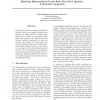UAI
1998
14 years 1 months ago
1998
Qualitativeprobabilistic reasoningin a Bayesiannetworkoften reveals tradeoffs: relationships that are ambiguousdue to competingqualitative influences. Wepresent twotechniquesthat ...
UAI
1998
14 years 1 months ago
1998
We take another look at the general problem of selecting a preferred probability measure among those that comply with some given constraints. The dominant role that entropy maximi...
UAI
1998
14 years 1 months ago
1998
UAI
1998
14 years 1 months ago
1998
We present an anytime algorithm which computes policies for decision problems represented as multi-stage influence diagrams. Our algorithm constructs policies incrementally, start...
UAI
1998
14 years 1 months ago
1998
We study two-layer belief networks of binary random variables in which the conditional probabilities Pr childjparents depend monotonically on weighted sums of the parents. In larg...
UAI
1998
14 years 1 months ago
1998
UAI
1998
14 years 1 months ago
1998
People using consumer software applications typically do not use technical jargon when querying an online database of help topics. Rather, they attempt to communicate their goals ...
UAI
1998
14 years 1 months ago
1998
Causal models defined in terms of a collection of equations, as defined by Pearl, are axiomatized here. Axiomatizations are provided for three successively more general classes of...
UAI
1998
14 years 1 months ago
1998
tigate the use of temporally abstract actions, or macro-actions, in the solution of Markov decision processes. Unlike current models that combine both primitive actions and macro-...
UAI
1998
14 years 1 months ago
1998
Dynamic probabilistic networks are a compact representation of complex stochastic processes. In this paper we examine how to learn the structure of a DPN from data. We extend stru...






